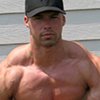- 1) Tell you what I learned from the book
- 2) State who I feel will benefit from reading it
- 3) Pick out main points and discuss them
- 4) And probably a couple other things :)
I was at my local library looking through the shelves, when I saw this thick book just calling my name. I pulled it from the shelves and saw the pic of Arnold flexing his bicep on the cover. I, being a big fan of Arnold, decided to get this book. The book is around 800 pages long and filled with great pictures of bodybuilders. At first, this book was a little intimidating because it is 800 pages long, but I finished it in one week. So anywayz, let's get to the book.
This book is divided into five books each with chapters.
Book 1
The first 90 pages give you a look into the history of bodybuilding. You get to see pictures of past and present bodybuilders.
Book 2
Next Arnold goes into basic training principles, like what is a rep, a set, and what various equipment is used for. Then you learn about different body types people have.
A point I picked up from this section is: When picking someone's physique that you want to work toward achieving, you should pick someone who has a body type like yours. For example, a person who has a thick endomorphic body type should not strive to look like Frank Zane.
Book 3
Next Arnold goes through a basic training routine and some intensity boosting techniques like super-setting, forced reps, and slow negatives.
Arnold then devotes over 300 pages to an exercise guide. Arnold goes through each body part, giving ways to stretch the muscle and train weak points. This exercise guide is pretty in-depth and gave me a lot of ideas. Each exercise has pictures and instructions on how to do them. I enjoyed seeing the intensity Arnold put into his workouts through some of these pictures.
Book 4
This book was the most beneficial book for me. This book deals with competing. Chapter 1 goes into posing. In this chapter you see many pictures of bodybuilders doing various poses.
The main thing I picked out from this section was: *When deciding what poses to add to your routine, you should pick poses which best display your physique, not what poses work for someone else. Arnold also gives you competition tips on tanning, hairstyles, and other things.
Book 5
Book 5 dealt with nutrition. Here Arnold talks about different diets, supplements, vitamins, and minerals. The last part of the book talks about injuries and how to treat them.
What I learned!
The main thing I learned from this book is to keep an open mind. Sometimes when you are taught principles from one person, you think that what that person said is right and nothing else is. For example AST says to do exercises in the 4-6 rep range, which I have been doing lately. Many people think this is the only way to go, but they are wrong. There are benefits in the 4-6 rep range, but there are also benefits in the 8-10 rep range. I realized that from reading this book. I have also begun thinking about my next routine and how I plan on implementing different techniques in it. I also learned about working weak areas first in your workout. I have heard and done this before, but I realized exactly how important it is. In my previous routine, I had my calf and forearm exercises at the end of my workouts. I realized I was not putting enough effort into working them. Therefore, I put them in there own workout. This worked great! I did them after biceps, so I still had a lot of energy. I was able to concentrate on them and really work them.
Who will benefit from reading this book:
I feel everyone could benefit from this book because of how inspirational it is. As for information, beginners to intermediate lifters would benefit from it. Most of the material in the book, I had already been exposed to. The only thing I do not like in this book is the routine. The routines Arnold gives suggest working your entire body two to three times a day by lifting six days a week. I believe with this kind of routine, your body would not have enough time to recover fully. I do not want to give away too much info on the book because I believe, You should read it!
So check this book out, it is pretty cool and informative. Check out your local library. Or if you want to buy it, it is only $25.
If you have something that you think I should add to my report, email me at dspikehead@hotmail.com
Derek Charlebois
